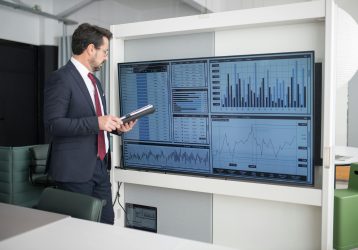Do brick-and-mortar offices still have their place?
As we transition to the post-pandemic era, many CEOs, HR teams and property managers are rethinking the role of physical office space. During the pandemic, as dust built up on office tables and file cabinets, employees were able to maintain their productivity at a distance. When employees are ideally set up to work from home, how do companies approach at-home and in-office work?
For most companies, the pre-COVID-19 work model, with employees coming to the office Monday to Friday, 9 to 5, is a thing of the past. With co-working spaces, flexible schedules and flexible working arrangements, these days it is all about flexibility. And this is to people’s liking: according to a survey conducted by KPMG, 71% of Canadians think that a hybrid workplace or hybrid office should be the new norm.
Although people go to the office to get work done, the office is, at the same time, a place to unite around a common vision. It is the anchor of the company’s culture—a source of team spirit and shared purpose.
The workplace facilitates connections and discussions and fosters innovation through collaboration (often informal). The office should be a place to gather as a team, move projects forward and give employees working remotely an opportunity to socialize. There are a number of studies showing that face-to-face interactions result in greater engagement and better cooperation.
To support this new direction, companies need to rethink their workspaces. This means saying goodbye to the long rows of individual partitioned cubicles: spaces must be designed for collaboration and brainstorming. Many companies have implemented an office management method called hotelling—a desk sharing system that simplifies the assignment of temporary workspaces. Several platforms, including Kadence and Envoy, offer practical solutions for employing this management method.
In addition to being shareable, workspaces should be conducive to interaction and teamwork. The Harvard Business Review cites the Olympic House in Lausanne, Switzerland, as a prime example of this. Everything from the layout to the building materials was chosen to foster discussion in common spaces. This includes the impressive central staircase and the comfy work islands.

Photo © 2019 / International Olympic Committee (IOC) / Mørk, Adam
In popular culture, the water cooler is a symbol of time wasting in the workplace. However, we have begun to appreciate how important informal interactions are for the work dynamic. Discussions around the water cooler or coffee pot may be casual, but they are far from pointless. This is one of the major shortcomings of remote work: the lack of informal space for impromptu conversations and deskside chats.
“I didn’t know you were working on this project! You should talk to Joanne. She did a market analysis that you might be interested in.” “Isabelle tells me that you do competitive mountain biking. Next week I’m meeting with a potential client in the outdoor recreation industry. Do you mind taking a look at my marketing plan?” These are examples of discussions that are unlikely to happen in virtual meetings, as one tends to follow the next at a dizzying pace, leaving little time for socializing.
For team cohesion, people need to connect on an emotional and human level. When every meeting has a purpose—as is always the case with virtual meetings—people lose the chance to socialize. It is difficult to quantify this lack of spontaneity and its ramifications. However, most employees do feel these repercussions—especially new employees. When employees are onboarded remotely, they often need more time to fully understand the inner workings and unspoken rules of a company
The hybrid work model is taking shape at this very moment. So no one has the perspective at this time to advise your company on the ideal dynamic in terms of in-office versus at-home work.
However, here are a few things you can do to ensure a smooth transition:
Par contre, pour réussir votre transition, il importe de :
As employees begin to seek greater flexibility, companies need to rethink the role of physical office space. We have seen that employees do not need to be at the office to be productive. If your employees do decide to come to the office to collaborate and have discussions, your job is to ensure that the spaces available to them are flexible and adapted to this kind of work.

Hiring the right executive is always important, but when you’re looking for a leader to guide your organization through uncertainty, the stakes are entirely different.

As we face one of the largest leadership turnovers in modern history, executive onboarding has become a defining factor in business continuity.

In today’s volatile economy, executive retention has become one of the most pressing priorities for organizations seeking stability and long-term growth.